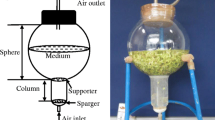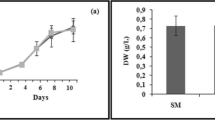Abstract
Extracts from Nostoc sp. biomass (CE) were compared with yeast extract (YE) in the formulation of media for cultivation of Rhizobium etli and Bradyrhizobium japonicum. Growth depended on the rhizobium strain and also on the type and concentration of the extract. The growth kinetics of R. etli were substantially influenced by the addition of CE an YE at concentrations between 0.3 and 1% (w/v); cultures containing YE showed shorter lag periods and higher growth rates and those with CE presented higher growth yields. Depending on the extracts, a different behaviour was displayed by the cultures at the stationary phase; cell viability increased or remained fairly constant in cultures developed on CE, and those developed on high concentrations of YE showed a decline in viable cell counts.
Similar content being viewed by others
References
Arias, A. & Martinez-Drets, G. 1976 Glycerol metabolism in Rhizobium. Canadian Journal of Microbiology 22, 150–153.
Association of Official Analytical Chemists 1975 Official Methods of Analysis, 12th edn. Washington DC: AOAC.
Bissonnette, N., Lalande, R. & Bordeleau, L.M. 1986 Large-scale production of Rhizobium meliloti on whey. Applied and Environmental Microbiology 52, 838–841.
Bjälfve, G. 1962 Nitrogen fixation in cultures of algae and other microorganisms. Physiologia Plantarum 15, 122–129.
Boiardi, J.L. & Ertola, R.J. 1985 Rhizobium biomass production in batch and continuous culture with a malt-sprouts medium. MIRCEN Journal of Applied Microbiology and Biotechnology 1, 163–172.
Burton, J.C. 1979 Rhizobium species. In Microbial Technology, ed Peppler, H.J. pp 29–59. New York: Academic Press.
Date, R.A. 1972 Sources and quantities of yeast extract for growth of rhizobia. Journal of Applied Bacteriology 35, 379–387.
Dubois, M., Gilles, K.A., Hamilton, J.K., Roberts, P.A. & Smith, F. 1956 Colorimetric method for determination of sugars and related substances. Analytical Chemistry 28, 350–356.
Fingerhut, U., Webb, L.E. & Soeder, C.J. 1984 Increased yields of Rhizobium japonicum by an extract of the green alga, Scenedesmus obliquus (276-3a). Applied Microbiology and Biotechnology 19, 358–360.
Frey, S.W. 1964 The determination of copper, iron, calcium, sodium and potassium in beer by atomic absorption spectro-photometry. Atomic Absorption Newsletters 3, 127.
Ghai, S.K., Hisamatsu, M., Amenura, A. & Harada, T. 1981 Production and chemical composition of extracellular poly-saccharides of Rhizobium. Journal of General Microbiology 122, 33–40.
Gulati, S.L. 1979 New nonsynthetic medium for Rhizobium culture production from wastes. Biotechnology and Bioengineering 21, 1507–1515.
Jauhri, K.S. & Gupta, M. 1989 Harvesting high cell densities for development of Rhizobium cell concentrate. Current Science 58, 1260–1262.
Lambert, M. & Neish, A.C. 1950 Rapid method for estimation of glycerol in fermentation solutions. Canadian Journal of Research 28, 83–89.
Meade, J., Higgins, P. & O'Gara, F. 1985 Production and storage of Rhizobium leguminosarum cell concentrates for use as inoculants. Journal of Applied Bacteriology 58, 517–524.
Periminova, G.N. 1972 In Method of Study and Practical Use of Soil Algae. Report of Kirov Agricultural Institute. Kirov, pp. 221–223.
Postgate, J.R. & Hunter, J.R. 1963 The survival of starved bacteria. Journal of Applied Bacteriology 26 295–306.
Pradella, J.G., Oliveira, M.S., Zuccolo, M., Severo, A.C. & Bonomi, A. 1994 Improved culture media for growth of Brady-rhizobium japonicum. World Journal of Microbiology and Biotechnology 10, 112–113.
Pushparaj, B., Pelosi, E., Carlozzi, P. & Torzillo, G. 1995 Yield and biochemical composition of a marine cyanobacterium (Nodularia sp.) in outdoor culture. Aquatic Microbial Ecology 9, 13–16.
Sherwood, M.T. 1972 Inhibition of Rhizobium trifolii by yeast extracts or glycine is prevented by calcium. Journal of General Microbiology 71, 351–358.
Silva, H.J., Cortiñas, T.I. & Ertola, R.J. 1989 Effect of nutritional factors on the culture of Nostoc sp. as a source of phyco-biliproteins. Applied Microbiology and Biotechnology 31, 293–297.
Vincent, J.M. 1970. In Manual for the Practical Study of Root-Nodule Bacteria, IBP handbook No 15. Oxford: Blackwell Scientific.
Author information
Authors and Affiliations
Rights and permissions
About this article
Cite this article
Silva, P., Gonza´lez, D., Aguilar, E. et al. Nutritional evaluation of Cyanobacterium (Nostoc sp.) extract in Rhizobium cultures. World Journal of Microbiology and Biotechnology 14, 223–228 (1997). https://doi.org/10.1023/A:1008834230171
Issue Date:
DOI: https://doi.org/10.1023/A:1008834230171




